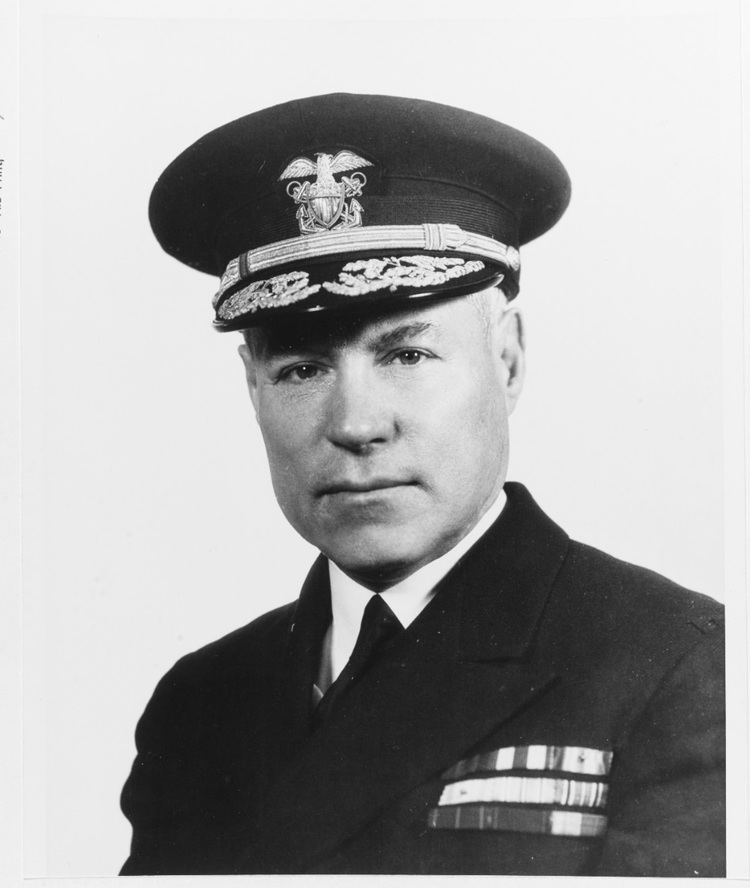Years of service 1909–1946 | Name Harold Train | |
 | ||
Born October 15, 1887Kansas City, Missouri ( 1887-10-15 ) Allegiance United States of America Battles/wars Occupation of NicaraguaWorld War IWorld War II Commands held United States naval districts, USS Arizona, USS Parrott (DD-218) | ||
Harold Cecil Train (October 15, 1887 – September 7, 1968) was a Rear admiral in the United States Navy who served as the Director of the Office of Naval Intelligence between years 1942–1943 and as Commanding Officer of the Battleship USS Arizona. He was father of Admiral Harry D. Train II and grandfather of Rear admiral Elizabeth L. Train.
Contents
Early life
Harold C. Train was born on October 15, 1887 in Kansas City, Missouri as the son of real estate dealer, Harry Depue (1860 - 1915) and Dora Elizabeth Langdon Train (1864 - 1916). He attended the local public schools Kansas City and subsequently entered the United States Naval Academy in Annapolis, Maryland.
Train graduated from the Academy on June 4, 1909 with the rank of passed midshipman and was assigned to the armored cruiser USS West Virginia. After two years of service at sea, then required by law, he was commissioned Ensign on June 5, 1911.
In March 1912, Train was transferred to the armored cruiser USS California. Aboard that ship, Train was appointed a Company commander of the California Battalion ashore during the Revolution in Nicaragua. Train subsequently served aboard gunboat USS Yorktown, operating in the Mexican waters. Then he spent several months as Engineer officer aboard the ship USS Cheyenne.
During World War I, Train was assigned to the Office of Naval Communications, Navy Department in Washington, D.C.. Finally he went overseas in March 1918, when he was assigned Executive officer of the USS Siboney, which was tasked with the transport of the troops to the Europe.
World War II
Captain Train was appointed a Commanding officer of the battleship USS Arizona on February 3, 1940 and served in this capacity for one year. Then he became a Chief of Staff with Battle Force under the command of Vice admiral William S. Pye.
During the Japanese Attack on Pearl Harbor, Captain Train issued orders for the battleship USS Nevada not to sortie, in order to minimize the damage of the ship and avert the possibility of the sinking and blocking the Pearl Harbor channel. For his conduct during the attack, Train was awarded with Navy Commendation Medal with Combat "V" from the commander of the Pacific Fleet, admiral Chester W. Nimitz.
Train then spent almost three months as Chief of Staff with admiral Nimitz Pacific Fleet, before he was ordered to report to the Office of the Chief of Naval Operations, admiral Ernest King. His next assignment was capacity of Director of the Office of Naval Intelligence in which he replaced rear admiral Theodore S. Wilkinson on July 20, 1942. Train was promoted to the rank of Rear Admiral a month later.
In September of the next year, rear admiral Train was transferred to the Balboa, Panama, where he was appointed a Commander of 15th Naval District, Panama Sea Frontier and Commander Southeast Pacific Force. In this capacity, he replaced rear admiral Clifford E. Van Hook and was responsible for the securing of Panama Canal besides his other duties. For his service in this capacity, he was awarded with Legion of Merit by the Army.
He was relieved of that command on June 10, 1944 and succeeded by Captain Ellis S. Stone and transferred back to the United States for further assignment. He was subsequently assigned to the Joint Post-War Committee within Joint Chiefs of Staff in Washington, D.C. This work include diplomatic assignments with the U.S. Delegation at Dumbarton Oaks Conference and to the United Nations organization and its first meetings in San Francisco.
After the Japanese surrender, Rear admiral Train remained on active duty as Senior Naval Member of the Joint Post-War Committee until his retirement. He was decorated by the Army with the Oak Leaf Cluster to his Legion of Merit for the service with these Committee.
Postwar life
Train retired from the Navy on May 1, 1946 and subsequently accepted the capacity of Superintendent of the Admiral Farragut Academy in St. Petersburg, Florida. After his second retirement, he lived with his wife in Bethesda, Maryland, where he died on September 7, 1968.
He was survived by his wife May Philipps Train (1889 - 1980), daughters Marion, Harriett, Jane and son Harry D. Train II (future Admiral in the United States Navy). He was also grandfather of Rear admiral Elizabeth L. Train.
Decorations
Rear Admiral Harold C. Train´s ribbon bar:
